 What is white, slightly overweight and even really fast within the framework of their genes? No, we are not writing about a full Snow White on Speed, but the Galax GeForce GTX 1070 Ti Hall of Fame, which is sold in Europe under the brand KFA2 for trademark reasons. It is now the spearhead of the manufacturer's product portfolio, at least as far as the GeForce GTX 1070 Ti is concerned.
What is white, slightly overweight and even really fast within the framework of their genes? No, we are not writing about a full Snow White on Speed, but the Galax GeForce GTX 1070 Ti Hall of Fame, which is sold in Europe under the brand KFA2 for trademark reasons. It is now the spearhead of the manufacturer's product portfolio, at least as far as the GeForce GTX 1070 Ti is concerned.
Compared to the GeForce GTX 1070 Ti EX that has already been tested, the manufacturer is now going the exact opposite way and packs everything up and down the map that could be worth it to the customer to buy exactly this model and no other. With an RRP of 490 euros, it would be a bargain by now, but more on that later.
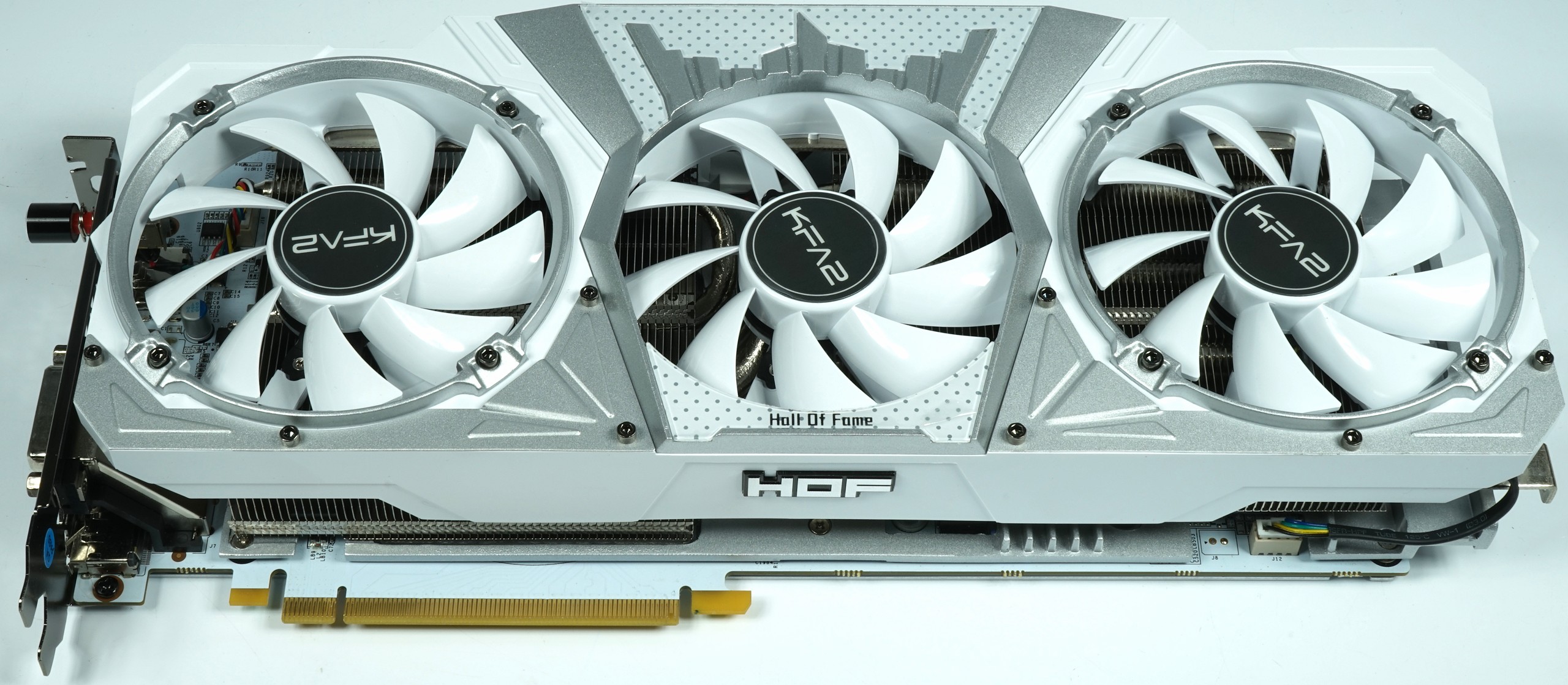
The scope of delivery is correct, because besides various gimmicks and giveaways there is even a solid graphics card holder, so that the beauty does not miss a witch's shot and does not leave a crooked hump.
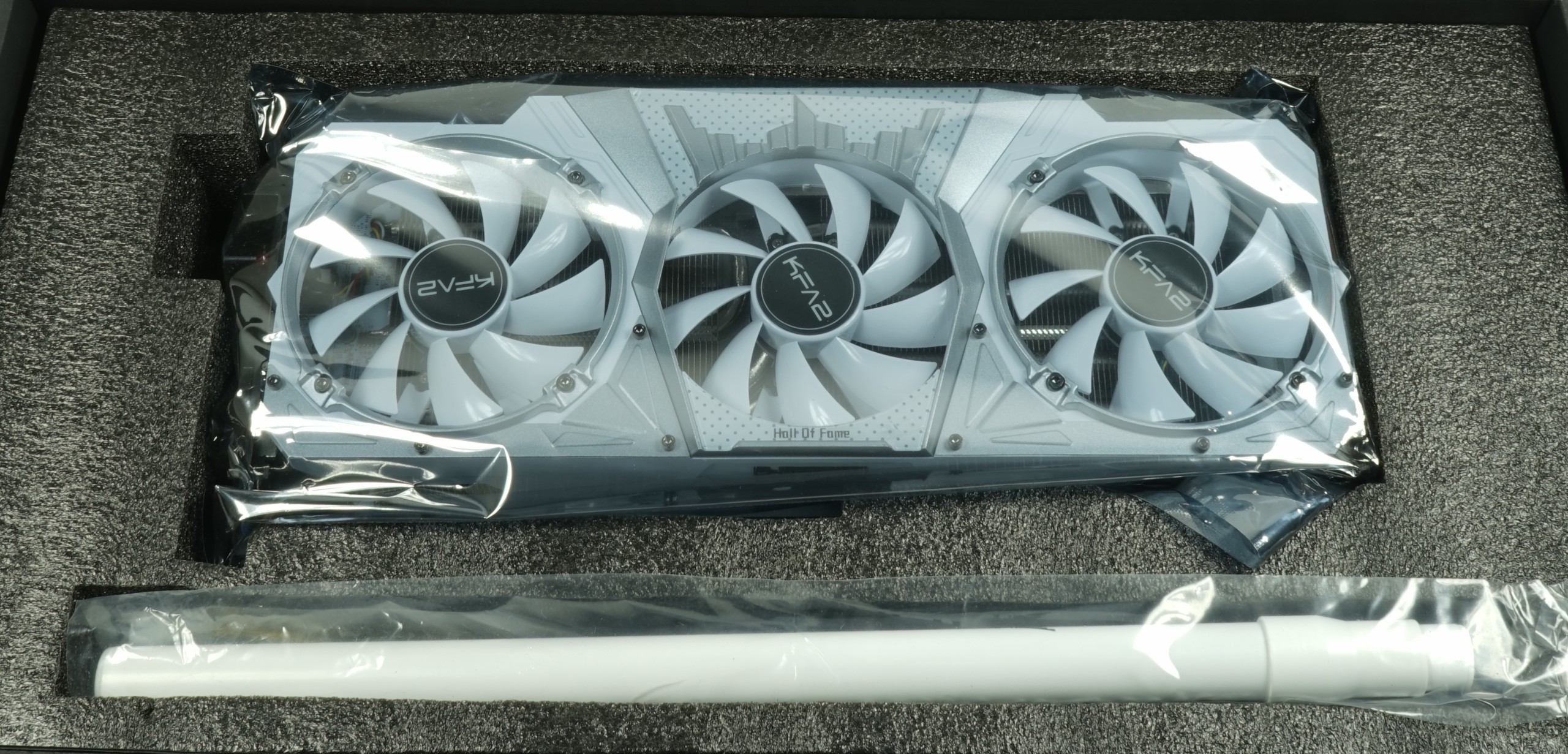
Since the actual performance of all board partner cards of the GeForce GTX 1070 Ti ex works has to be very similar due to the fixed base and boost offset for all manufacturers, the real achieved results depend more on the actual achieved in practice. Boost cycle, and thus indirectly from the cooling and primarily also the quality of the respective chip.
Each test based on benchmark bars is therefore only a random snapshot of a single specimen. This is precisely why we have focused on the actual technical implementation of each model and have been able to document this very well with our equipment.
Within the necessary tolerance ranges, it is definitely NOT possible that the performance of a particular card could be preceded by all others. We have therefore no longer used a manufacturer's name for the benchmarks, because according to chip quality, any card from any manufacturer can tend to the lower or upper performance limit.
The manufacturer offers a one-click OC on via software to circumvent these restrictions imposed by Nvidia, but we would rely on a real, manual OC. Why, you can read in the article.
Unboxing, dimensions and connections
We will discuss the exact board and cooling design separately later. The most important features are first summarized in a table:
| Overview of installation dimensions, features and connections | |
|---|---|
| Installation length: |
31.5 cm (slot aperture to end cover) |
| Installation height: |
13.0 cm (upper edge slot to top edge card) |
| Depth: |
5.0 cm (2 slot) 0.5 cm baking plate |
| Weight: |
1276 grams |
| Backplate: | Yes, without cooling function |
| Cooling: | Air Vertical-aligned cooling fins |
| Fan: |
3x 9 cm fan modules 9 rotor blades non-semi-passive regulated |
| Connections Slot blend: |
3x DisplayPort 1.4a 1x HDMI 2.0 1x Dual-Link DVI-I |
| Other connections: |
2x SLI Connector |
| Power supply: |
8-Pin + 8-Pin PCI-Express |
Exterior views
The radiator cover is made of white plastic with various plastic applications, at least metallic, and backlit surfaces. Full RGB, of course. After the unboxing, the first optical and haptic impression is quite fine, even if you have to like the somewhat jagged plastic mountains of course. So it's more for flavour mountaineers and not for lowlands that stand on flattened lowlands.
The card is already heavyweight with its 1276 grams, which also explains the meaning of the included graphics card holder. The length of 31.5 cm, however, is literally outstanding. The height of 13 cm is average, but the installation depth of 5 cm is quite pummish.
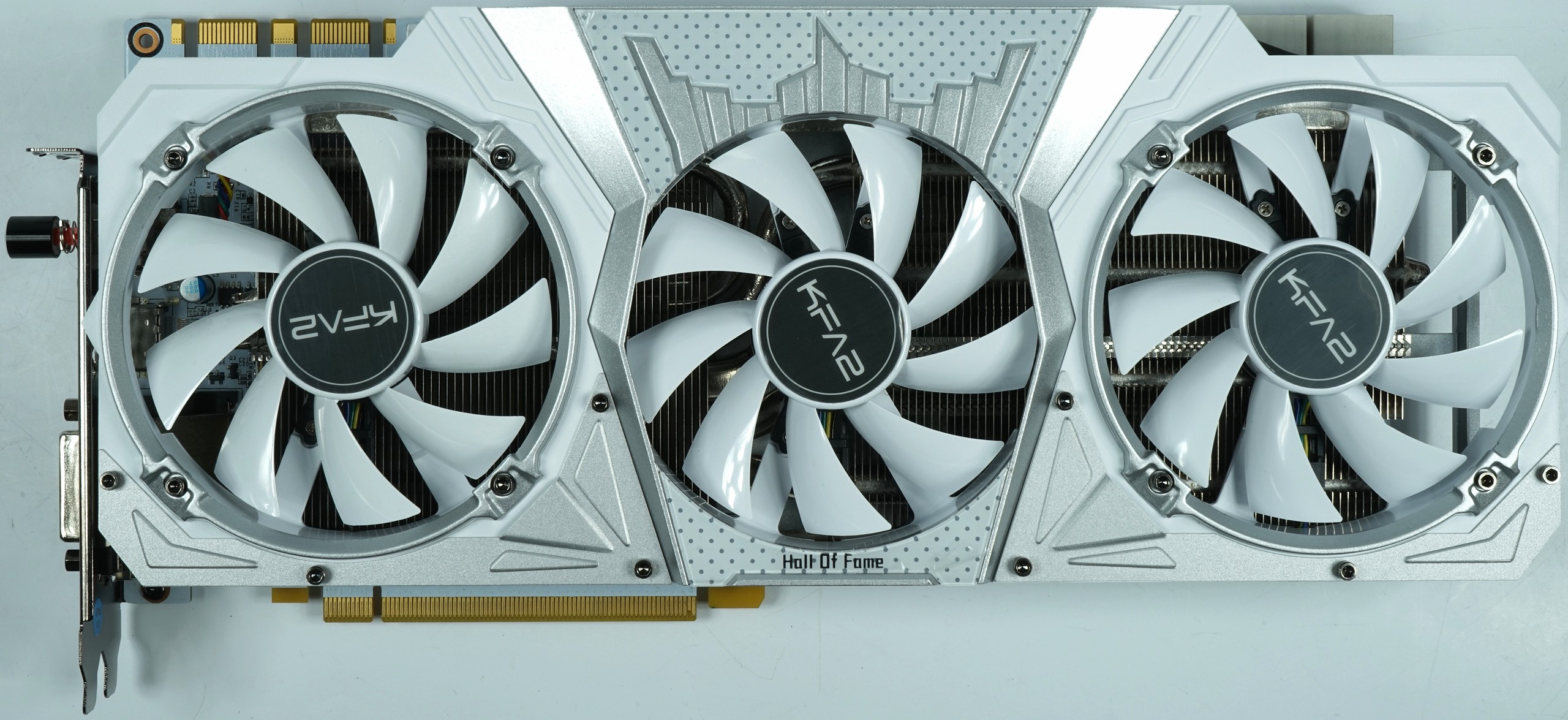 |
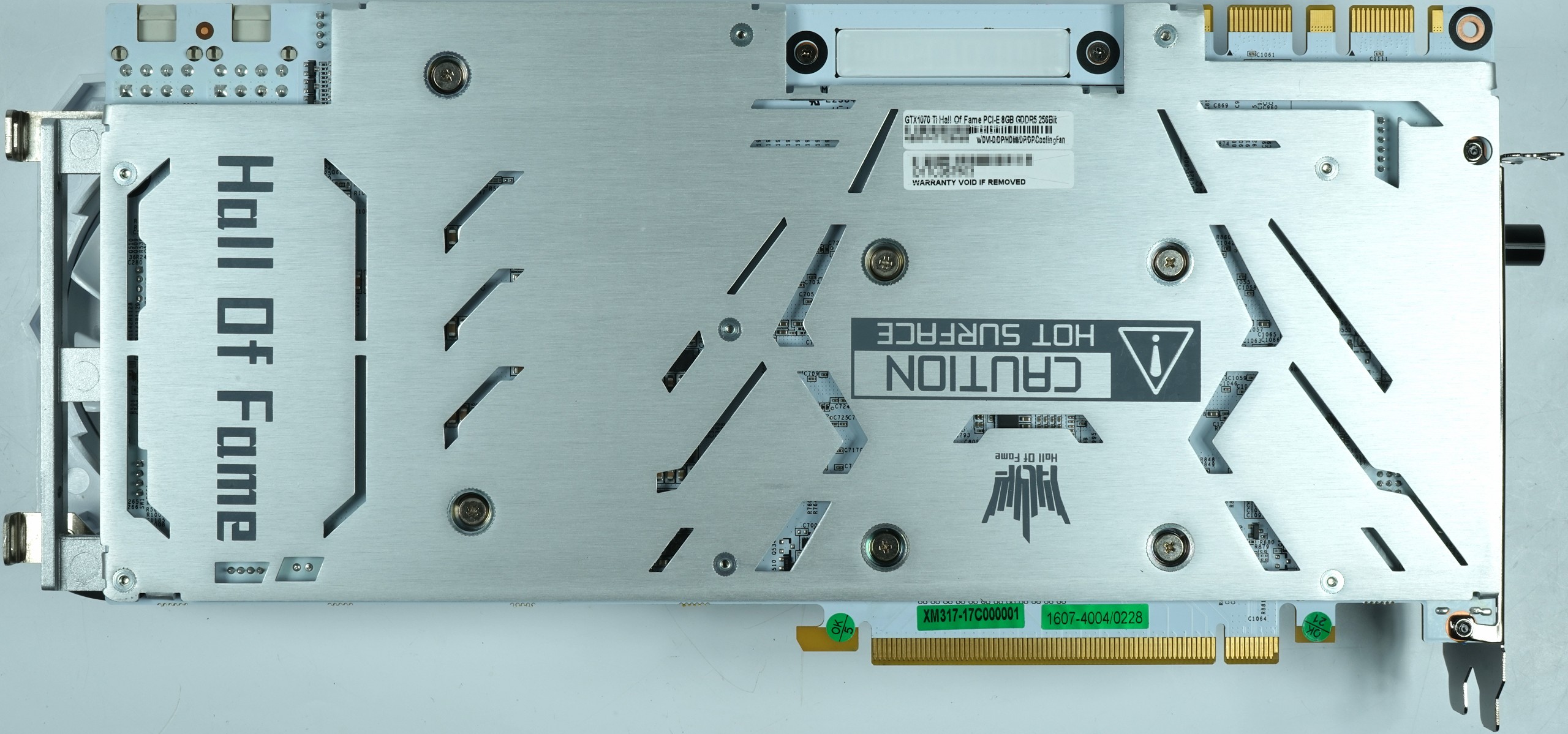 |
The back of the board is covered by a one-piece, externally brushed and blackened inside aluminum backplate, which has various ventilation slots and openings. For this backplate, you have to plan for at least another five millimeters depth on the back, which could be important for multi-GPU systems. The bottom of the card bears a "HoF" logo, which you will probably never see again after installation until the removal.

The top of the card has a "Hall of Fame" lettering with LED backlight and two 8-pin external PCIe power connectors at the end of the graphics card.

The end of the map shows, like its underside, that the slats are vertically aligned and thus no air flow towards the end of the map or Slot aperture goes. Almost half are pressed towards the motherboard, which is not really the evolutionary crown. However, one can now argue about what is counterproductive in the end, because multiple curved heatpipes for a horizontal design do not make the transport of waste heat exactly more efficient.
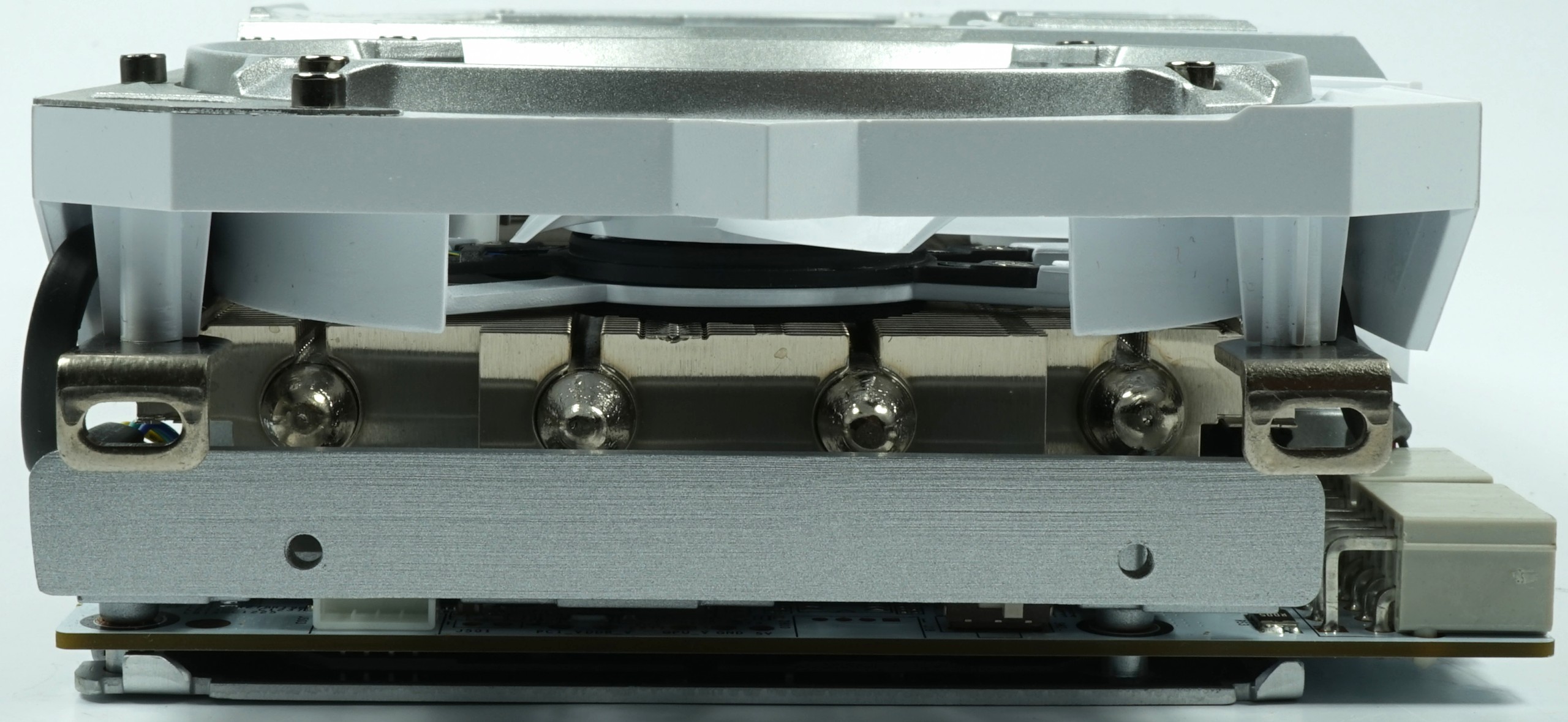
The slot aperture offers a total of five outputs, of which a maximum of four can be operated together (multi-monitor setup). In addition to the dual-link DVI-D (no analog signal looped through!), there is an HDMI 2.0 output and three DisplayPort 1.4 ports on the back. The rest of the slot aperture is provided with some openings for the air outlet, which hardly fulfils a real function.
The small DIP switch, which is almost hidden and unreachable, is used to switch to a second (although in this case completely identical BIOS) and is unfortunately not documented by Galax/KFA2. But good to know that you would have more security for a flash, in case of cases.
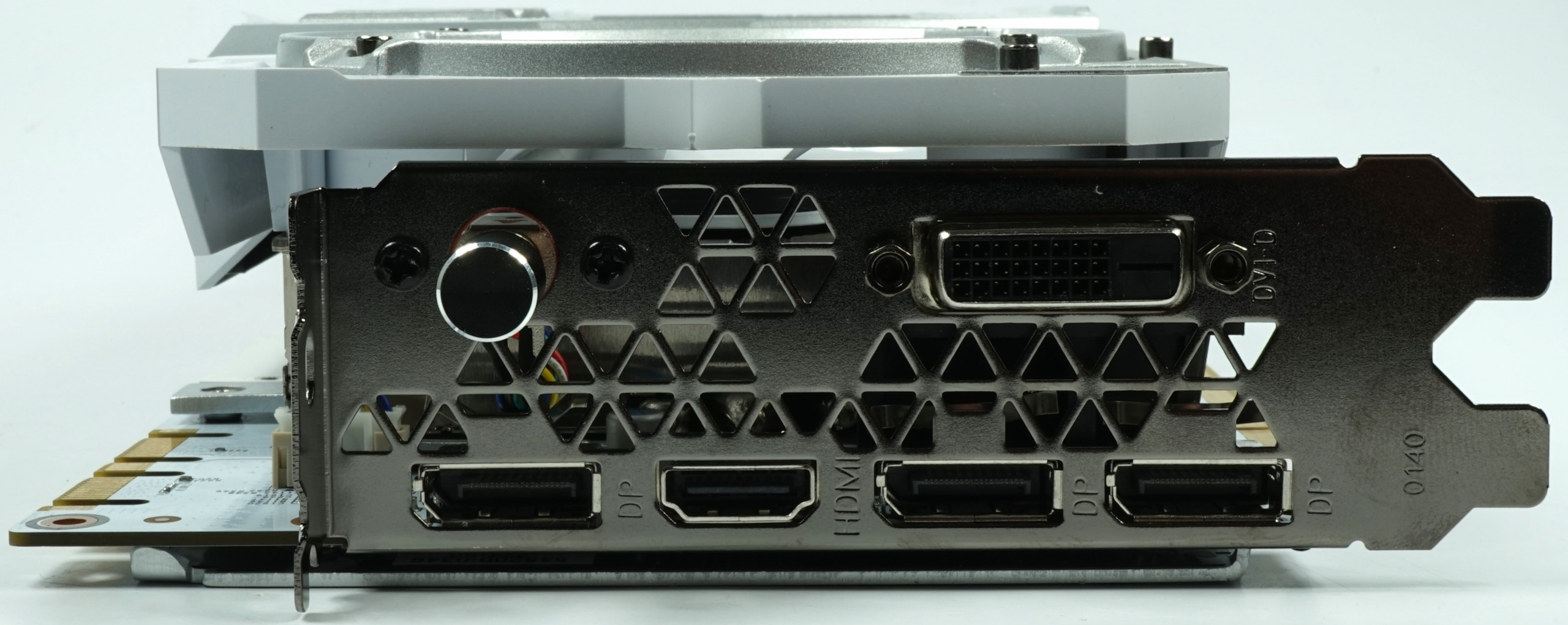
The switch is used to increase the fan speed to 100%. Sense or nonsense? At least we have provided enough fresh air with a simple push of a button for later overclocking.
Specifications
Since the ex-factory specifications must be the same for all GeForce GTX 1070 Ti, the following table applies equally to all cards:
| Gpu |
GeForce GTX 1080 (GP104) |
GeForce GTX 1070 Ti (GP104) | GeForce GTX 1070 (GP104) |
|---|---|---|---|
| Sms |
20 | 19 |
15 |
| CUDA Cores |
2560 | 2432 |
1920 |
| Base Clock |
1607 MHz |
1607 MHz |
1506 MHz |
| GPU Boost Clock |
1733 MHz | 1683 MHz |
1683 MHz |
| GFLOPs (Base Clock) |
8228 | 7816 |
5783 |
| Texture Units |
160 | 152 |
120 |
| Texel Fill Rate |
277.3 GT/s | 244.3 GT/s |
201.9 GT/s |
| Memory Data Rate |
10 Gb/s | 8 Gb/s |
8 Gb/s |
| Memory Bandwidth |
320 GB/s | 256 GB/s |
256 GB/s |
| Rops |
64 | 64 |
64 |
| L2 Cache |
2MB | 2MB |
2MB |
| Tdp |
180w |
180w |
150w |
| Transistor |
7.2 billion | 7.2 billion |
7.2 billion |
| The Size |
314 mm2 | 314 mm2 | 314 mm2 |
| Process Node |
16nm | 16nm | 16nm |
Test system and measurement methods
The new test system and the methodology have already been described in great detail in the basic article "How We Test Graphics Cards" (English: "How We Test Graphics Cards") and therefore, for the sake of simplicity, we now only refer to this detailed Description. So if you want to read everything again, you are welcome to do so. However, we have improved CPU and cooling once again in order to largely exclude possible CPU bottle necks for this fast card.
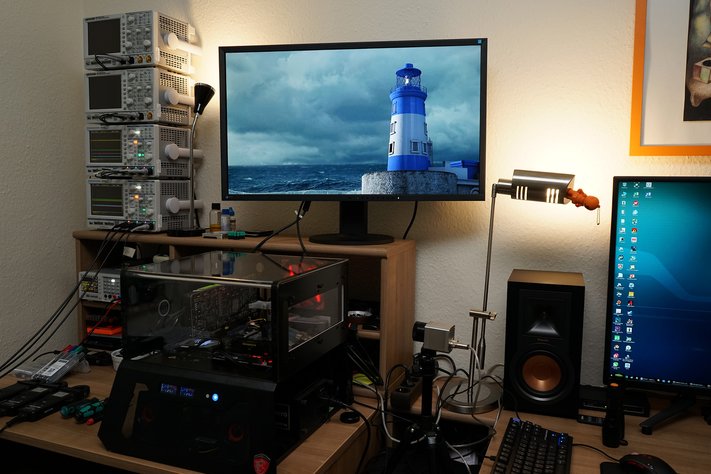
If you are interested, the summary in table form quickly provides a brief overview:
| Test systems and measuring rooms | |
|---|---|
| Hardware: |
Intel Core i7-6900K -4.3GHz MSI X99S XPower Gaming Titanium Corsair Vengeance DDR4-3200 1x 1 TByte Toshiba OCZ RD400 (M.2, System SSD) 2x 960 GByte Toshiba OCZ TR150 (Storage, Images) Be Quiet Dark Power Pro 11, 850-watt power supply Windows 10 Pro (all updates) |
| Cooling: |
Alphacool Ice Block XPX Alphacool Ice Age 2000 Chiller 2x Be Quiet! Silent Wings 3 PWM (Closed Case Simulation) Thermal Grizzly Kryonaut (for cooler change) |
| Housing: |
Lian Li PC-T70 with expansion kit and modifications Modes: Open Benchtable, Closed Case |
| Monitor: | Eizo EV3237-BK |
| Power consumption: |
non-contact DC measurement on the PCIe slot (Riser-Card) non-contact DC measurement on the external PCIe power supply Direct voltage measurement on the respective feeders and on the power supply 2x Rohde & Schwarz HMO 3054, 500 MHz multi-channel oscillograph with memory function 4x Rohde & Schwarz HZO50, current togor adapter (1 mA to 30 A, 100 KHz, DC) 4x Rohde & Schwarz HZ355, touch divider (10:1, 500 MHz) 1x Rohde & Schwarz HMC 8012, digital multimeter with storage function |
| Thermography: |
Optris PI640, infrared camera PI Connect evaluation software with profiles |
| Acoustics: |
NTI Audio M2211 (with calibration file) Steinberg UR12 (with phantom power for the microphones) Creative X7, Smaart v.7 own low-reflection measuring room, 3.5 x 1.8 x 2.2 m (LxTxH) Axial measurements, perpendicular to the center of the sound source(s), measuring distance 50 cm Noise in dBA (Slow) as RTA measurement Frequency spectrum as a graph |
































Kommentieren